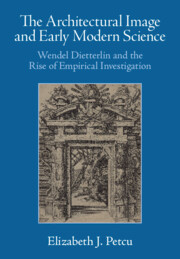 The Architectural Image and Early Modern Science
The Architectural Image and Early Modern Science Book contents
- The Architectural Image and Early Modern Science
- Reviews
- The Architectural Image and Early Modern Science
- Copyright page
- Dedication
- Contents
- Editorial Note
- Acknowledgements
- Introduction The Renaissance of Architecture as Art and Science
- One Architecture’s Figural Turn
- Two Devising the Architectura: Rationalism and Empiricism in Architectural Design
- Three Drafting the Architectura: Drawing as Research in Art, Architecture, and Science
- Four Printing the Architectura: Architectural Etching Becomes Alchemical Inquiry
- Five Dissecting the Architectura: Anatomy, Ornament, and the Limits of Figuration
- Six Deconstructing the Architectura: Enduring Matter and Transient Forms in Peru
- Conclusion The Death and the Life of the Architectural Image
- Select Bibliography
- Index
Conclusion - The Death and the Life of the Architectural Image
Published online by Cambridge University Press: 29 November 2024
- The Architectural Image and Early Modern Science
- Reviews
- The Architectural Image and Early Modern Science
- Copyright page
- Dedication
- Contents
- Editorial Note
- Acknowledgements
- Introduction The Renaissance of Architecture as Art and Science
- One Architecture’s Figural Turn
- Two Devising the Architectura: Rationalism and Empiricism in Architectural Design
- Three Drafting the Architectura: Drawing as Research in Art, Architecture, and Science
- Four Printing the Architectura: Architectural Etching Becomes Alchemical Inquiry
- Five Dissecting the Architectura: Anatomy, Ornament, and the Limits of Figuration
- Six Deconstructing the Architectura: Enduring Matter and Transient Forms in Peru
- Conclusion The Death and the Life of the Architectural Image
- Select Bibliography
- Index
Summary
The legacy of Dietterlin’s Architectura is evident in the enduring role of empiricism across seventeenth-century architecture and natural philosophy. The Architectura served as the culmination of a breed of architectural image-making informed by the humanistic philosophy of learned empiricism, which intertwined the iconography of the fantastical and the occult with empirical ideas and practices. The decline of learned empiricism’s influence over architectural images is already anticipated in Dürer’s Melencolia I, which inspired the final etching of Dietterlin’s Architectura as an elegy to that tradition. Dietterlin’s contributions to the consolidation of architectural images as platforms for empirical scientific inquiry, as well as the waning of learned empiricism, resonated in seventeenth-century England and France, where architectural images eschewed symbolic representations for a novel visuality that foregrounded purely empirical evidence. Dietterlin’s Architectura catalyzed the new relationship between architecture and science by exposing the limits of humanist symbolism and the vast potential of architectural images as agents of empirical thinking, philosophy, and practices.
Keywords
- Type
- Chapter
- Information
- The Architectural Image and Early Modern ScienceWendel Dietterlin and the Rise of Empirical Investigation, pp. 399 - 417Publisher: Cambridge University PressPrint publication year: 2024
